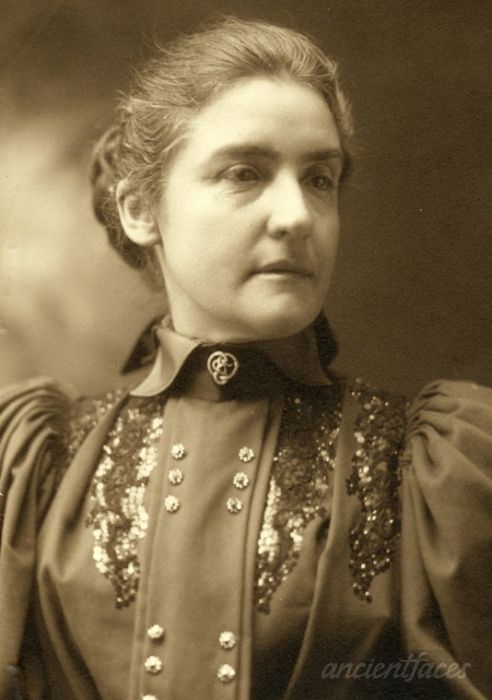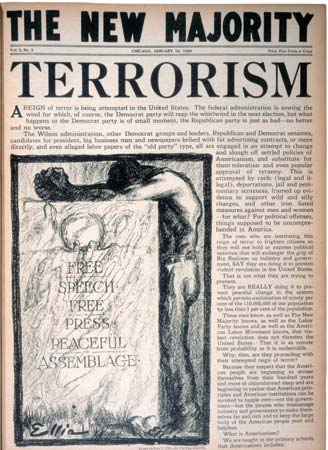January 02
CAREY THOMAS, American educator, born (d: 1935); One of the most prominent American educators of the early 20th century, M. Carey Thomas shared her home with another woman while serving as the second president of the women-only Bryn Mawr College in Pennsylvania. Martha Carey Thomas was the eldest of ten children of a Quaker couple in Baltimore, Maryland. Her mother was active in the Women's Christian Temperance Union and her physician father became a trustee of Johns Hopkins University.
Few Victorian women pursued advanced education or careers, but, encouraged by her family to view herself as the equal of any man, Thomas did so. After obtaining a B.A. in classics from Cornell University in 1875, she tried to obtain a graduate degree from Johns Hopkins University. The school would not permit Thomas to attend classes with men, and she withdrew in frustration.
Leaving the United States for Europe, Thomas studied in Leipzig, Germany. When professors at Leipzig refused to examine a woman for the doctorate degree, she transferred to the University of Zurich in Switzerland. In 1882, she became the first woman and the first foreigner to obtain that school's doctorate summa cum laude.
Appointed to a post at newly established Bryn Mawr in Pennsylvania in 1883, Thomas became the first dean of an American women's college to hold a doctorate. Named president in 1894, she boosted the scholarly reputation of the school by seeking only the ablest scholars for the faculty, recruiting Woodrow Wilson among others. She encouraged non-traditional attitudes among the undergraduates and strongly supported academic and professional careers for women, famously stating "our failures only marry."
Education of a Woman, published in 1900, established Thomas's international reputation as the leading authority on the higher education of women. Recognizing the importance of women's roles in Progressive-era social reform, Thomas also found time to contribute to the establishment of the Johns Hopkins University School of Medicine and the Bryn Mawr Summer School for Women Workers.
While in Europe, Thomas had lived with Mamie Gwinn, a childhood friend with whom she enjoyed a "romantic friendship." This arrangement continued at Bryn Mawr, where Gwinn also taught. The two women openly shared a home on the college campus until Gwinn married in 1904. (Gertrude Stein immortalized the messy break-up in her story Fernhurst, probably written in late 1904.)
While involved with Gwinn, Thomas had pursued a relationship with Mary Garrett (1839-1915), a philanthropist and heiress to the Baltimore and Ohio Railroad fortune. Deeply committed to women's rights, in 1893 Garrett made a sizable gift in support of the Johns Hopkins University Medical School, on condition that the new school admit women on an equal basis. Her philanthropy also benefited the women's suffrage movement.
After Gwinn and Thomas separated, Garrett and Thomas became a couple, living together at the college until Garrett's death. Garrett bequeathed the bulk of her estate to Thomas. Thomas retired in 1922 and succumbed to heart failure on December 2, 1935.
Thomas never publicly discussed her sexuality, but there is a strong presumption that she was a Lesbian. After analyzing Thomas's reading, her biographer Helen Lefkowitz Horowitz argued that the Bryn Mawr president was well aware of the possibilities for physical love between women and of the medically oriented literature on sexuality that began to appear in the late nineteenth century.
Thomas is notable for managing to carve out a large role for women in the world of academia. While her sexual orientation cannot be proved beyond doubt, her pioneering educational achievements established the groundwork that made it possible for generations of other women to pursue lives free from financial and emotional dependence upon men.
CHRISTOPHER DURANG, born on this date, (d: April 2024) was an American playwright known for works of outrageous and often absurd comedy. His work was especially popular in the 1980s, though his career seemed to get a second wind in the late 1990s.
Sister Mary Ignatius Explains It All For You was Durang's watershed play as it brought him to national prominence when it won him the Obie Award for Best Playwright (1980). His play Vanya and Sonia and Masha and Spike won the Tony Award for Best Play in 2013. The production was directed by Nicholas Martin, and featured Sigourney Weaver, David Hyde Pierce, Kristine Nielsen, Billy Magnussen, Shalita Grant and Genevieve Angelson. Durang was a past co-director of the Lila Acheson Wallace American Playwrights Program at Juilliard.
Much of Durang's style can be attributed to the aesthetic of black comedy, a humor style that offers a fatalistic view of life. Durang discusses the particular frame of mind that requires the viewer to distance himself from the horrific episode of human suffering and pain; he explains: "I exaggerate awful things further, and then I present it in a way that is funny, and for those of us who find it funny, it has to do with a very clear suspension of disbelief. It is a play, after all, with acted characters; it allows us a distance we couldn’t have in reality. To me this distance allows me to find some rather serious topics funny."
Durang lived in Pipersville, Pennsylvania, with his husband, actor/playwright John Augustine. They began their relationship in 1986 and were legally married in 2014.
In 2016, Durang was diagnosed with logopenic progressive aphasia, which is thought to be caused by a form of Alzheimer's disease; as with all forms of aphasia; ironically, it primarily impeded his ability to process language, though it subsequently affected his short-term memory. Durang gradually withdrew from public life before his condition was publicly announced in 2022. Durang died from complications of aphasia at his home on April 2, 2024, at the age of 75.
If you think the Patriot Act or Donald Trump's rantings are something new, be advised of THE PALMER RAIDS which began in the United States, less than 90 years ago. The Palmer Raids were a series of controversial raids by the U.S. Justice and Immigration Departments from 1919 to 1921 on suspected radical leftists in the United States. The raids are named for Alexander Mitchell Palmer, U.S. Attorney General under Woodrow Wilson.
The crackdown on radical left-wing political groups had actually begun during WWI. After a series of bomb attacks of court buildings, police stations, churches and homes attributed to violent immigrant anarchist groups, the Department of Justice and its small Bureau of Investigation (BOI) (predecessor to the FBI) had begun to track their activities with the approval of President Wilson. In 1915, Wilson warned ofhyphenated Americans who have poured the poison of disloyalty into the very arteries of our national life. Such creatures of passion, disloyalty and anarchy must be crushed out.
Handicapped by the secrecy of these groups and limited Federal law enforcement capabilities, the Bureau of Investigation significantly increased its workload on anarchist movements after 1917 when the Galleanists (followers of Luigi Galleani) and other radical groups commenced a new series of bomb attacks in several major American cities. The Russian Revolution of 1917 was also a background factor: many anarchists believed that the worker's revolution there would quickly spread across Europe and the United States.
On June 15, 1917, Congress passed the Espionage Act. The law set punishments for acts of interference in foreign policy and espionage. The act authorized stiff fines and prison terms of up to 20 years for anyone who obstructed the military draft or encouraged "disloyalty" against the U.S. government. After two anarchist radicals, Emma Goldman and Alexander Berkman, continued to advocate against conscription, Goldman's offices at Mother Earth were thoroughly searched, and volumes of files and detailed subscription lists from Mother Earth, along with Berkman's journal The Blast, were seized. As a Justice Department news release reported: A wagon load of anarchist records and propaganda material was seized, and included in the lot is what is believed to be a complete registry of anarchy's friends in the United States. A splendidly kept card index was found, which the Federal agents believe will greatly simplify their task of identifying persons mentioned in the various record books and papers. The subscription lists of Mother Earth and The Blast, which contain 10,000 names, were also seized.
In 1919, J. Edgar Hoover was put in charge of a new division of the Justice Department's Bureau of Investigation, the General Intelligence Division. By October 1919, Hoover's division had collected 150,000 names in a rapidly expanding index. Using this information, starting on November 7, 1919, BOI agents, together with local police, orchestrated a series of well-publicized raids against suspected radicals and foreigners, using the Espionage Act of 1917 and the Sedition Act of 1918. Palmer and his agents were accused of using torture and other controversial methods of obtaining intelligence and collecting evidence on radicals, including informers and wiretaps.
Victor L. Berger was sentenced to twenty years in prison on a charge of sedition, although the Supreme Court of the United States later overturned that conviction. The radical anarchist Luigi Galleani and eight of his adherents were deported in June 1919, three weeks after the June 2 wave of bombings. Although authorities did not have enough evidence to arrest Galleani for the bombings, they could deport him because he was a resident alien who had overtly encouraged the violent overthrow of the government, was a known associate of Carlo Valdonoci and had authored an explicit how-to bomb making manual titled La Salute é in Voi (The Health is Within You), used by other Galleanists to construct some of their package bombs.
In December 1919, Palmer's agents gathered 249 people of Russian origin, including well-known radical leaders such as Emma Goldman and Alexander Berkman, and placed them on a ship bound for the Soviet Union (The Buford), called the Soviet Ark by the press). In January 1920, another 6,000 were arrested, mostly members of the industrial Workers of the World union. During one of the raids, more than 4,000 individuals were rounded up in a single night. All foreign aliens caught were deported, with no requirement that there be any evidence against them, under the provisions of the Anarchist Act. All in all, by January 1920, Palmer and Hoover had organized the largest mass arrests in U.S. history, rounding up at least 10,000 individuals.
Louis F. Post, then Assistant Secretary of Labor, cancelled more than 2000 of these warrants as being illegal. Of the many thousands arrested, 550 people were actually deported. For most of 1919 and early 1920, much of the public sided with Palmer, but this soon changed. Palmer announced that an attempted Communist revolution was certain to take place in the U.S. on May 1, 1920 (May Day). No such revolution took place, leading to widespread derision of Palmer. Once seen as a likely presidential candidate, he lost the nomination of the Democratic Party to dark horse candidate James M, Cox.
On September 16, 1920, a violent blast rocked Wall Street. The Wall Street Bombing killed 38 people and wounded over 400; it was never solved but was widely attributed to radical anarchists.
As Winston Churchill opined: “America always does the right thing...after it’s tried everything else.”Of course, nowadays, Tea Partiers and the Radical rightwing reactionaries can assert their right to overthrow the government with seeming impunity. Threats of armed insurrection and "nullification" (one of the main issues that precipitated the Civil War) are, it seems, commonplace in the public "discourse." Not sure if this is progress or not.
Subscribe to Gay Wisdom
Would you like to have Today in Gay History (aka Gay Wisdom) sent to you daily?



